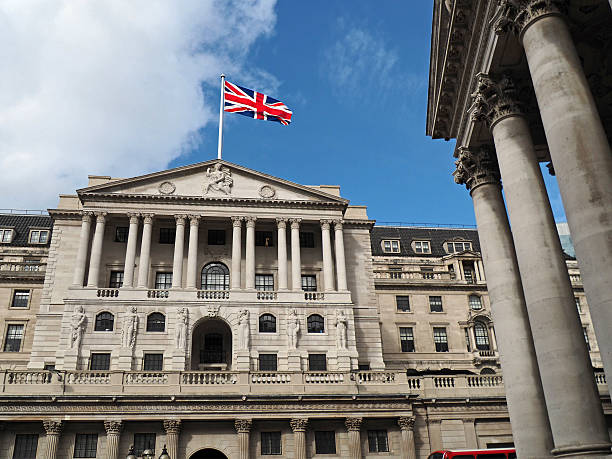BoE expected to keep interest rate unchanged at 5% as price pressures persist
- Gold remains bid as lack of Fed clarity and geopolitical frictions persist
- U.S. November Nonfarm Payrolls: What Does the Rare "Weak Jobs, Strong Economy" Mix Mean for U.S. Equities?
- Tesla Stock Hits Record High as Robotaxi Tests Ignite Market. Why Is Goldman Sachs Pouring Cold Water on Tesla?
- U.S. November CPI: How Will Inflation Fluctuations Transmit to US Stocks? Tariffs Are the Key!
- AUD/USD remains depressed below mid-0.6600s; downside seems limited ahead of US NFP report
- December Santa Claus Rally: New highs in sight for US and European stocks?

The Bank of England is set to hold its interest rate at 5.0% on Thursday.
United Kingdom’s annual inflation was stable at 2.2% in August.
BoE policy announcements are likely to rock the Pound Sterling.
After a close call in August, the Bank of England’s (BoE) September interest rate decision is keenly awaited for fresh cues on the bank’s future policy action and the pace of its bond sales.
Thursday’s meeting is not a “Super Thursday” – there won’t be any Monetary Policy Report (MPR) or a press conference from Governor Andrew Bailey –, but the United Kingdom (UK) central bank’s announcements at 11:00 GMT are likely to have a significant impact on the performance of the Pound Sterling (GBP).
What to expect from the Bank of England policy announcements?
The Bank of England is widely expected to hold the key interest rate at 5.0% following its September policy meeting, with the key focus likely on the language in the policy statement and the Monetary Policy Committee’s (MPC) voting composition.
The BoE is seen sticking to its cautious stance on the easing path amid elevated services inflation in the UK, as it awaits the Autumn Budget from the new Labour government on October 30. No new economic projections could also dissuade the central bank from committing to any forward guidance.
Back in August, the BoE lowered the key policy rate by 25 basis points (bps) to 5.0% from 5.25%, with a 5-4 MPC vote in favor of such a move. Chief Economist Huw Pill preferred to maintain the rate at 5.25%.
Jonathan Haskel, another MPC member, voted to keep rates on hold in August but he has since been replaced by Alan Taylor. Markets are uncertain about Taylor’s policy stance, anticipating him to go with the majority during his first rate-setting meeting.
August inflation data released on Wednesday showed that the Consumer Price Index (CPI) rose at an annual pace of 2.2%, staying above the BoE’s 2.0% target while coming in below the central bank’s expectations of 2.4% in the reported period. However, the rebound in the UK services inflation to 5.6% in August from July’s 5.2% remains a cause for concern, adding to the odds that the BoE will maintain its cautious outlook on the policy path.
Adding to this, Althea Spinozzi, Head of Fixed Income Strategy at Saxo Bank said, “while wage growth has surprised to the downside, with the 3-month average weekly earnings at 4% (down from 4.5%), it remains significantly higher than pre-pandemic levels. This is keeping real disposable income elevated compared to the 2010-2020 average, adding to the inflationary backdrop.”
Previewing the BoE policy decision, Althea noted: “The Bank of England is expected to keep rates steady in September, reflecting a cautious approach due to persistent inflation, especially in services, and elevated wage growth.”
“The BoE is likely to announce a further £100 billion reduction in gilt holdings in the next twelve months, reducing the need for active sales, which could provide fiscal relief for the government in light of the Autumn Statement,” she added.
How will the BoE interest rate decision impact GBP/USD?
The Pound Sterling has entered a consolidative phase against the US Dollar, having tested offers above the 1.3200 threshold earlier this week. Will the BoE policy verdict revive the GBP/USD uptrend?
If the BoE communication suggests the bank’s prudence on the future easing cycle, markets would perceive that as a hawkish hold, providing a fresh boost to the Pound Sterling. In such a case, GBP/USD could stretch higher toward the 1.3300 mark. Alternatively, should the central bank acknowledge the progress in the disinflationary trend and express concerns over the economic prospects, it could fan expectations for further rate cuts this year, dragging the pair back toward 1.3000.
Dhwani Mehta, Asian Session Lead Analyst at FXStreet, offers a brief technical outlook for GBP/USD:
“The GBP/USD pair settled Wednesday above the falling trendline resistance on the daily chart at 1.3199, yielding a technical breakout. The 14-day Relative Strength Index (RSI) holds comfortably above the 50 level, currently near 60, suggesting that upside risks remain intact in the near term.
“Buyers, however, need to find a strong foothold above the 1.3250 psychological level to take on the upside. The next topside barriers are seen at the multi-year high of 1.3297 and 1.3350. Alternatively, acceptance below the 21-day Simple Moving Average (SMA) at 1.3153 is critical for a sustained correction. Further down, the July 17 high of 1.3045 will come to the rescue of the Pound Sterling should the downside extend. At that level, the 50-day SMA hangs around,” Dhwani adds.
Economic Indicator
BoE Interest Rate Decision
The Bank of England (BoE) announces its interest rate decision at the end of its eight scheduled meetings per year. If the BoE is hawkish about the inflationary outlook of the economy and raises interest rates it is usually bullish for the Pound Sterling (GBP). Likewise, if the BoE adopts a dovish view on the UK economy and keeps interest rates unchanged, or cuts them, it is seen as bearish for GBP.
Next release: Thu Sep 19, 2024 11:00
Frequency: Irregular
Consensus: 5%
Previous: 5%
Source: Bank of England
BoE FAQs
The Bank of England (BoE) decides monetary policy for the United Kingdom. Its primary goal is to achieve ‘price stability’, or a steady inflation rate of 2%. Its tool for achieving this is via the adjustment of base lending rates. The BoE sets the rate at which it lends to commercial banks and banks lend to each other, determining the level of interest rates in the economy overall. This also impacts the value of the Pound Sterling (GBP).
When inflation is above the Bank of England’s target it responds by raising interest rates, making it more expensive for people and businesses to access credit. This is positive for the Pound Sterling because higher interest rates make the UK a more attractive place for global investors to park their money. When inflation falls below target, it is a sign economic growth is slowing, and the BoE will consider lowering interest rates to cheapen credit in the hope businesses will borrow to invest in growth-generating projects – a negative for the Pound Sterling.
In extreme situations, the Bank of England can enact a policy called Quantitative Easing (QE). QE is the process by which the BoE substantially increases the flow of credit in a stuck financial system. QE is a last resort policy when lowering interest rates will not achieve the necessary result. The process of QE involves the BoE printing money to buy assets – usually government or AAA-rated corporate bonds – from banks and other financial institutions. QE usually results in a weaker Pound Sterling.
Quantitative tightening (QT) is the reverse of QE, enacted when the economy is strengthening and inflation starts rising. Whilst in QE the Bank of England (BoE) purchases government and corporate bonds from financial institutions to encourage them to lend; in QT, the BoE stops buying more bonds, and stops reinvesting the principal maturing on the bonds it already holds. It is usually positive for the Pound Sterling.
Read more
* The content presented above, whether from a third party or not, is considered as general advice only. This article should not be construed as containing investment advice, investment recommendations, an offer of or solicitation for any transactions in financial instruments.

